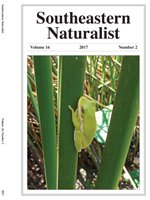The Altamaha River region of southeastern Georgia is widely recognized for its biodiversity and conservation value for imperiled species. Even so, intensive amphibian and reptile surveys have never been conducted in this area. From 2008 to 2016, we conducted herpetofaunal surveys at 13 conservation lands located along the Altamaha River and along the lower reaches of a main tributary, the Ocmulgee River. We used a variety of field methods including visual encounter surveys, turtle trapping, frog-call surveys, drift fences, and surveys for snakes at Gopherus polyphemus (Gopher Tortoise) burrows. From these data, combined with a review of the published literature and a search of relevant museum collections, we determined that conservation and other nearby lands along the Altamaha River support a diverse herpetofauna of 100 species, including 41 amphibian species (18 salamander and 23 frog and toad species) and 59 reptile species (1 crocodilian, 11 lizard, 33 snake, and 14 turtle species). Seventeen species (12 reptile and 5 amphibian species) that are either federally listed, state-listed, or tracked as special concern by the Georgia Department of Natural Resources have been documented here, and sandhills along the Altamaha River support significant populations of Gopher Tortoises, Drymarchon couperi (Eastern Indigo Snake), and Crotalus adamanteus (Eastern Diamond-backed Rattlesnake). Biogeographically, the Altamaha River is a notable influence on the distributions of many amphibians and reptiles. High species richness, including many declining species, underscores the Altamaha River's importance to conservation, and future efforts should focus on long-term monitoring of imperiled species and effective management of conservation lands.
How to translate text using browser tools
1 June 2017
The Herpetofauna of Conservation Lands along the Altamaha River, Georgia
Dirk J. Stevenson,
Houston C. Chandler
ACCESS THE FULL ARTICLE

Southeastern Naturalist
Vol. 16 • No. 2
June 2017
Vol. 16 • No. 2
June 2017




